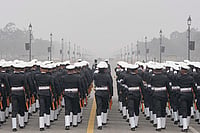Perched on a hilltop, just above the busy Shimla-Kinnaur highway, one doesn’t have to struggle to find a three-storey modest building—the Namgyal monastery, an extremely quiet quaint Tibetan temple. This is the home of 13 elderly Tibetan refugees, who had lived a life after being displaced and exiled in India, but today have nowhere to go at the fag end of their lives.
Many of them have no clue about their children or families while others see them once a year or maybe after many years. For them, an old age home makes a perfect setting to live in companionship at ease. They know returning to Tibet will never happen in their lifetime. It is care, prayers and comfort that keep them going, even as a few hardly have memories of life, or about Tibet.
This well-maintained old age home seems to be their last destination, to live and die with failed desires and their dream for a homeland perpetually deferred.
“Where do we go from here? For 64 years we have lived as an exiled community. Now India is our home. Our journey is over. I am only looking to go straight to the

The old age home, established in 1999, has a capacity to accommodate 50 inmates. Till some years ago, it had 30-40 elders but now there are just 13, including three women.
The elders look happy and content with the facilities the monastery offers―basic amenities, including two-time meals and breakfast, tea and momos. The only difference is that they are forced to carry their ‘exile’ with them.
They usually sit together and chat under the bright sun. But, many usually spend their time inside individual rooms where they recite Buddhist scriptures, count beads (japmala) and sleep most of the time.
The Old Age Care Home was inaugurated by former Chief Minister Virbhadra Singh―whose nameplate remains well preserved. The home has an ideal location―facing Shimla’s most preserved catchment forest, which brings fresh breeze in summer and the warmth of bright sunshine when Shimla gets covered with snow. A walking corridor with glazed transparent glass windows offers a fascinating view of the valley downhill.
“This is a wonderful place. I was sent here by Dalai Lama ji. I am living with his wishes and thus pray for his long life. He is God to us,” says Tsering adding, “When I hear the news about the situation in Tibet, I tell everyone that going back to Tibet will not come in my lifetime.” A retired soldier, who had also served as Tibetan spiritual leader Dalai Lama’s cook at McLeod Ganj, says he has no dreams left in the last stages of his exiled life. “My next destination can’t be Tibet, but the cremation ground,” he says, with a gentle smile on his face.
Tsering is the most agile person among all inmates and loves to interact with most visitors. Often, he goes out for walks or to fetch fruits from the nearby market.
“Everyone has gone. My two sisters, my wife, and two brothers. I’m just waiting to go. These are the last few days of my life,” he says.
As the caretaker of the Old Age Care Home–Lobsang Chomophel, a monk sits beside Tsering listening to the conversation. He reminds Tsering that he is a retired soldier.
“You were an army man in Tibet and thereafter, the Indian army. You will live 100 years. What is the worry?” says Lobsang, to cheer him up. Tsering becomes nostalgic.
“I was barely 25 and had joined the Army to serve my country—Tibet. I was posted at the borders and had not even got married. The Chinese came to Tibet in disguise of doing trade and started befriending the local communities. It was just like the East India Company. Slowly, they started showing their true colours, attacking and killing the Tibetans,” he recalls.
“There were incidents of firings, brutal killings. The Chinese took over the lands and properties of families. The Tibetans resisted, fought back and even got killed in the conflicts. One day, there was a massive attack on the army and its establishments,” he says.
Tsering says he fought as a guerrilla against the Chinese army in 1958. He was a trained gunner. Many soldiers got killed in the conflicts. But, a year later, he decided to give up and flee across the Himalayas, following the Dalai Lama’s escape.
It was 1959, when His Holiness Dalai Lama, then also 23, also escaped to India disguising himself as a soldier. Had he been captured by the Chinese, they would have certainly harmed him physically.
Tsering admits that he has forgotten many things about his life and escape. The families left everything back and walked miles and miles―hungry and clueless to save their lives. He lost his contact with sisters and other family members. It took him years to reunite in Assam at some refugee camps/homes.
Tsering had the opportunity to be a part of the Indian Peace Keeping Force in Bangladesh in 1971 and fought a battle for 16 days and thereafter celebrated the victory. “I wish this had happened in Tibetan when I was serving the army in my country,” he regrets.
The octogenarian Tibetan refugee is two of the oldest inmates at the Old Age Care Home and perhaps one of the most agile persons, who can narrate his experiences of the Tibetan uprising.
“Most of the inmates don’t talk much, few are hard of hearing or don’t know Hindi. One woman has dementia. Everyone has got individual rooms equipped with all the basic comforts, including water, utensils, cupboards, heaters for winter and medicines. We have provided everyone a private space for prayers and meditation or they can walk to the monastery,” says Lobsang.
The inmates are served breakfast early morning, thereafter lunch at 12 noon, tea twice a day and dinner at around 6 pm. Everyone has to come to the pantry to collect meals. A big metal bell in the compound is an alarm to invite them to collect the meals.
Rajesh Kumar, the state head of Helpage India, a leading non-profit organisation, caring for disadvantaged elderly senior citizens, says, “This Old Age Care Home is the best-managed shelter home of elderly persons. We provide all medical help, undertake necessary check-ups, spend time with them and provide them with free medicines and multi-nutrient products. Some of the old age exiled Tibetans―who had been nostalgic about Tibet, and even had a desire to go back―died here.”
So, if Tsering terms this Old Age Care Home as the last destination of his life, he is certainly right, Kumar acknowledges.
Do you have a desire to go back to Tibet? When asked,

, another inmate, nods “yes”, but soon turns off.
“I was a very little girl when the Tibetans were forced to leave the country by the Chinese army (the People’s Liberation Army). I have some memories of my childhood in Tibet and how her country looked like,” she says.
She says she worked as a labourer in the PWD (Public Works Department) to build roads in Himachal Pradesh to earn her living. One of the roads on which she worked for many years is the one that leads to the Tibetan borders (Kinnaur) from Shimla.
There are a few good things also which happened to Norbu Tsering. After serving in the army, he also became a member of Dalai Lama’s kitchen at McLeod Ganj, cooking food for him, and making soups.
“He is living God. He is full of compassion and human values. We are proud of him for emerging as a world leader. I am sure one day he will pave the way to Tibet’s freedom. Wish I can see that day,” he says.
Asked about the dietary routines of the Dalai Lama, Tsering says: “Lama ji (Dalai Lama) eats very less. No sugar, no oils, only boiled vegetables. Chakki ka atta is his favourite.”
Cheemi, 84, another inmate at the Old Age Care Home, could not speak in Hindi to share her feelings, but she could express the pain of being a refugee and having seen the displacements.
“Many young Tibetans born in exile in India may not even realise how their parents or grandparents managed to save themselves and struggled in India. Being a refugee is a pain,” admits Sherop, a cook at the old age home.
By this time, Tsering goes inside his room and brings out a bottle of Fanta—a cold drink—to serve. This was a sign to wind up the conversation so that he could go back to his room to rest. “Long live the Dalai Lama,” he says, as he begins to recite some Tibetan scriptures.


























